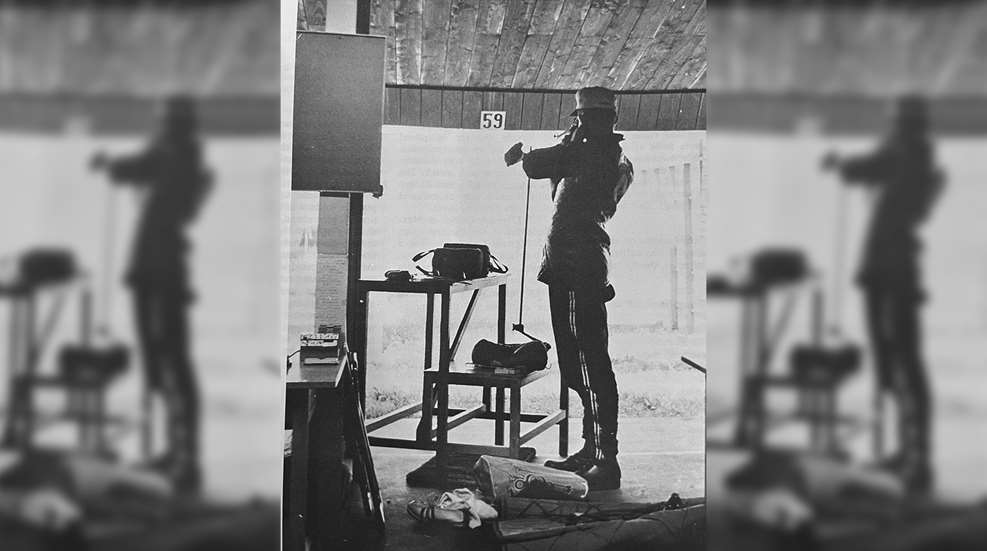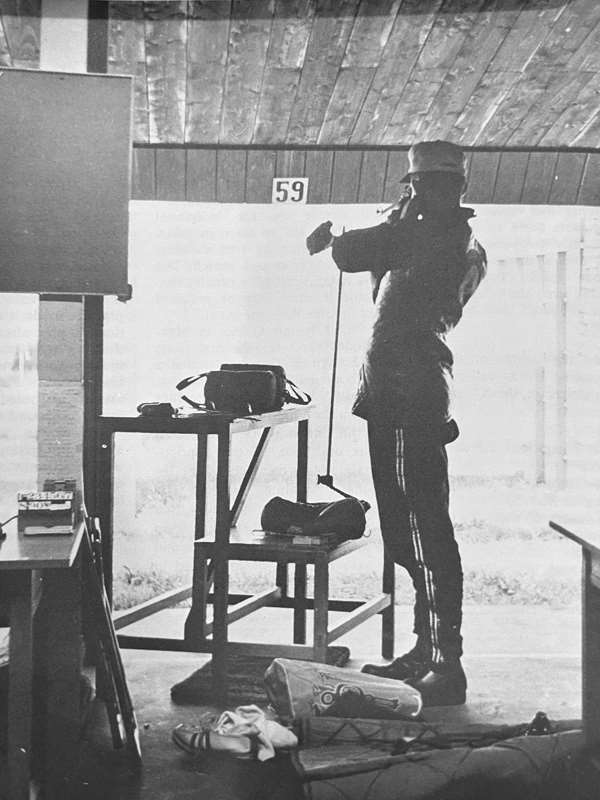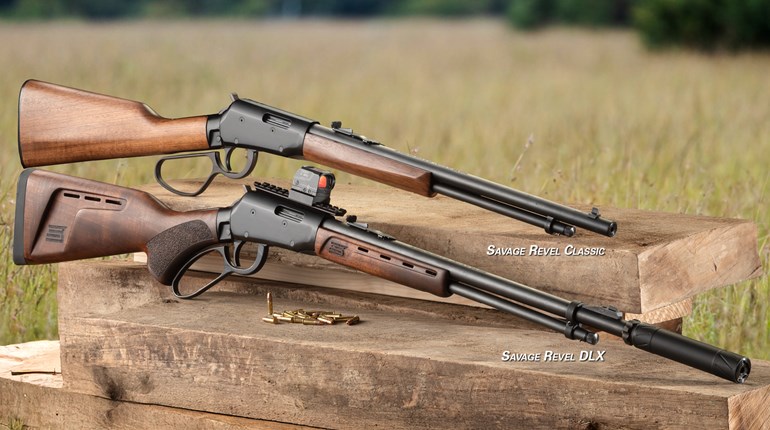
The below is an excerpt from the 1978 book, Olympic Shooting, written by Col. Jim Crossman and published by the NRA. (Read about the early history of smallbore rifle prone competition here.)
The Three-Position Rifle Matches
By Colonel Jim Crossman
The free rifle, three-position, 300-meter match has hardly changed in the last 50 years. It is still a long, tough, grueling event demanding sustained performance from the shooter and his equipment. It consists of 40 shots each in the prone, standing and kneeling positions at a range of 300 meters (328 yards). The whole target is only one meter (39.4 inches) across, with 10 scoring rings uniformly smaller down to the 10-ring, which is only 10 centimeters (3.94 inches) across. The time allowed for the full match, which includes up to 10 sighting shots in each position, is 5¼ hours—1½ hours prone, 1¾ hours kneeling, and two hours standing.
The free rifle must not weigh over eight kilograms (17.6 pounds) and the caliber must not exceed eight millimeters. The length of the buttplate is limited and telescope sights are not permit-ted, but almost anything else goes. The free rifle has a very elaborate stock, often with many adjustments so it can be made to fit the shooter in the different positions. The popular rifle action used to be the falling-block or Martini type, but specially designed bolt-action rifles are now widely used.
The match is fired in 10-shot strings, a fresh target being used for each string. The shooter can take sighting shots only between 10-shot strings. Though the value of each shot is marked by a scorer in the pits, the value is unofficial and the final score is determined in the statistical office, where the targets are carefully examined and plugged by target controllers who are not aware of the identity of the shooter. A tie is settled by the highest score in the prone position, followed by the highest score in the last 10 shots of the kneeling position.
The shooter fires from a shooting house which is closed on the top, rear, and sides to protect him from wind and sun. Often the shooting house is a large, elaborate building with adequate facilities for spectators. Rooms are provided for the officials as well as the shooters, where equipment may be stored and the shooters can rest. Although this match is certainly not the fastest-moving event in the sporting world, in many countries large crowds often gather to watch the shooters.
While the 1976 Olympic Games were awarded to Montreal on the understanding that they would put on the events as called for, after preparations had been under way for some time, Montreal suddenly announced that they would not schedule the 300-meter free rifle event. Whereupon, with amazing alacrity, the International Olympic Committee announced that this free rifle match would no longer be a part of the Olympic Games. All this to the dismay and consternation of the International Shooting Union which was not consulted on either decision. The UIT is making strenuous efforts to get this classic match back in the Games. [Editor’s note: Unfortunately, 300-meter never made it back to the Olympics, at least not as of 2022.]
The smallbore rifle three-position match is similar to the free rifle event and usually is shot from the same enclosed shooting house, but the target is only 50 meters away. The target has a 10-ring that is only 12.4 millimeters (0.49 inch) in diameter. One target is usually used for each shot, but it may be used for as many as 5 shots if a backing target is provided. The blank backing target is positioned a few inches behind the regular target so that shots from the wrong firing point can be traced.
The rifle is similar to the free rifle used at 300 meters except that the caliber is 5.6 millimeters (.22 rimfire).
Both matches call for tremendous shooting ability in all three positions, plus the endurance to handle an 18-pound rifle for 120 shots. The shooter must show great patience and painstaking care in firing each shot, exercising rigid self-control for 5½ hours, regardless of weather, spectators and range conditions.
Doping the wind is important. A 10-mile-an-hour wind, for example, is described as a pleasant breeze, but a 10-mile-an-hour breeze is enough to move a .22 bullet an inch or more at 50 meters, and a .30 caliber rifle bullet six inches or more at 300 meters. American shooters have sometimes used two kinds of high power rifle ammunition in international events, one to give the very best possible accuracy under good conditions and another to give good wind-bucking ability with moderate accuracy under poor conditions.
The three-position events are difficult matches. Anyone who turns in winning scores in these matches must put in a tremendous amount of effort and is a real champion.
American high power rifle shooting does not lead into the free rifle game. The rifles, the targets and the general conditions of the two types of shooting are different. While any shooting is useful in learning the fundamentals of sight alignment and trigger squeeze and the other basics, once these are in hand the prospective free rifle shooter must shoot over the free rifle course of fire.
It may be hard to find free rifle matches where the shooter can test what he has been practicing. But the practice and the matches do not necessarily have to be shot at 300 meters; there are targets reduced in size to give the same difficulty at the shorter ranges of 300 and 200 yards.

The free rifle has to be suitable to start with. Until Mike Walker of Remington got in the act, there had never been a good U.S.-made free rifle on the market. The Remington Model 40 series free rifle, developed in conjunction with the Army's Marksmanship Training Unit, is good; it is available in .22 rimfire or any of various center-fire cartridges. Tom Henshaw prompted Winchester to produce good International rifles based on the Model 70 and the Model 52 mechanisms.
Other popular rifles are imported. The Savage-Anschutz, a popular foreign rifle, is available in various calibers and types. The Finnish Lion, the Hammerli, the Schultz and Larson, the Tanner and the Walther are other specialized rifles designed for the free rifle shooter.
Free rifles are not cheap. A shooter might want to start by modifying his own match rifle with palm rest, hook buttplate, and set trigger. It may take time to develop the right ammunition for this rifle, but the effort is worth-while. The best rifle-ammunition combination may not win anything, but a poor combination can certainly lose.
Experts consider the free rifle game the most demanding of the shooting sports. It requires good physical condition, which calls for regular exercise. It requires good mental condition, which calls for exacting practice and extensive competition. And it requires good shooting condition, which includes extensive practice and careful analysis of past performances.
Russian shooter Anatoli Bogdanov calls the free rifle game "the sport of the will." The great American champion Gary Anderson agrees. He puts great emphasis on physical and mental conditioning, which come only from hard work, careful planning and a study of the shooter's development.
The three positions used in free rifle shooting—prone, kneeling, and standing—differ from the similar positions used in conventional U.S. rifle shooting. The prone position in free rifle shooting is much higher than is often used in U.S. rifle shooting, especially smallbore. The left hand must clear the ground by six inches. Although some foreign shooters position themselves directly behind the rifle, the best position seems to be with the shooter lying at an angle of 15 to 25 degrees behind the rifle. The right leg may be drawn up slightly and the left foot may rest on the toe or point to the right. The left arm supports most of the upper body weight, so it should be nearly vertical, which may not put it under the rifle.
The kneeling position is used little in American high power rifle shooting, although it is used widely in indoor gallery and outdoor .22 position shooting.
The free rifle kneeling position is generally quite high, with the shooter sitting back on his right heel. A pad under the instep—permitted under international rules—takes the load off the shooter's toes. With the shooter sitting well back and keeping his body erect, most of the weight is on the right foot. The head should be erect, rather than scrunched down to meet a rifle positioned low on the shoulder, and face nearly straight ahead to avoid looking at the target out the corner of the eyes. The left hand is pulled fairly well back and the right elbow is held only moderately high.
This is far different from a common American position shooter sitting on the side of the foot with the body hunched forward and the elbows barely off the ground. While the international position may look high and unstable, the best shooters show it to be the position for high scores. Kneeling is a more difficult position than prone and deserves a greater share of practice time.
Standing is the tough one, of course. The standing position is the least stable and the most tiring and, consequently, produces the lowest scores. In the 1964 Olympic Games, for example, the high 10 shooters in the 300-meter event averaged 390.0 prone, 382.3 kneeling and only 362.3 standing. In the smallbore rifle 3-position match the averages were 394.7 prone, 387.7 kneeling and 363.5 standing. Standing should get the most attention from the aspiring free rifle shooter.
The object of any position is to let the bones and ligaments of the body do as much work as possible and the muscles as little as possible. In the normal standing position, with his weight evenly on both feet, the shooter is in balance and the muscles do not work. But stick a 16-pound rifle in his left hand and his muscles begin to work hard to hold it, or else he changes his position.
Good free rifle shooters use a position with the upper part of the body bent to the right and rear, putting quite a curve in the spinal column. But this brings the center of gravity of the body and the rifle back where it belongs and, after the shooter gets used to it, the position is quite comfortable and steady.
Bogdanov says he can hold the rifle for five minutes or more without getting too wobbly.
The palm rest is held in the left hand, with the weight being transmit. ted down the forearm to the elbow, which rests on the hip. The hook of the buttplate fitting under the right arm prevents the muzzle-heavy rifle tipping over. The right arm can hang naturally or be raised slightly. The stock of the rifle must be brought up to meet the shooter's face, not the face brought down to the stock. The buttplate is adjusted so that an erect head position is possible.
Some slight adjustments may be necessary between the positions and technique used for the 300-meter event fired with the center-fire cartridge, and the smallbore free rifle match using the .22 rimfire cartridge. The differences are not great and the shooter can certainly work out all the fundamentals for either with dry firing and with the .22 rifle. There is much more chance for competition with the .22; also, there is quite a bit of indoor activity and some outdoor .22 position shooting. College programs are based on three-position shooting or the international events, which is the reason so many young international shooters have come from college teams.
As in all other shooting, competition is the payoff. At the same time, competition is training. It lets the shooter see how well he performs. And it is one more step in developing the will power that is needed so badly. A serious shooter cannot get too much competition, providing he shoots studiously and learns from his mistakes. There is nothing like competition to give a shooter buck fever and there is nothing like competition to get him over it.

































